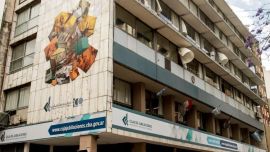Coastal edges with indigenous vegetation, trees and water plants, fish, birds, and even some coypuses (a sort of otter or water rodent) are the new setting for the Matanza-Riachuelo Watershed, which seems to have changed for good.
The typical picture of abandoned ships, destroyed wharves or cars sunk on the bed of the Riachuelo are now a distant memory. The unpleasant and distinctive smell after two centuries of pollution is not felt anymore either.
Now, after the cleaning works in the watershed, after the decision of the Mendoza Case, the traditional waterway which serves as a southern border for Buenos Aires City, which had become a true outdoor polluted deposit of industrial and toxic waste, is navigable once again. At least the section from the confluence with the River Plate up to the Nicolás Avellaneda Bridge, a few metres away from the Rocha Bend, can be used for tourism.
The decision was made after a motion filed before Federal Morón Criminal and Correctional Court no. 2 – which had suspended the navigability of the Matanza-Riachuelo River in 2011 – by the national Tourism & Sports Ministry with a view to encouraging river navigation in order to “promote sustainable environmentally-friendly tourism and recover a relationship with the river.”
From the portfolio headed by Matías Lammens they state that the plan is “for the boat service to unite the Delta with Quilmes to have a stop at La Boca and to begin operating by the end of the year.”
“The watershed’s situation has changed a lot in the last 15 years, but in the case of navigation, when the judge suspended it in 2011, the Riachuelo was different. The situation changed substantially, and thus the judge lifted the prohibition in that section,” said Martín Sabbatella, head of the Acumar Matanza-Riachuelo Watershed Authority.
“To be able to navigate the Riachuelo is a turning point between the original state of the waterway and its current condition. There’s still plenty of work to be done,” said Fabio Márquez, director of Acumar’s Social Participation Commission.
“Navigating means rubbish doesn’t get tangled in the propeller anymore, without nauseating smells and even observing a restored landscape on its banks which was not there 15 years ago,” he added.
Perfil had the chance to navigate the section from the Acumar quay, by the old Bosch Bridge, up to the confluence with the River Plate and check first-hand the true state of the river.
The old setting of floating rubbish, abandoned ships or banks occupied by underprivileged homes or unlawful industrial facilities has been replaced by an image of water birds and parks with playgrounds on the edges. Fish can also be seen.
“Now you can see the riverbanks with spontaneous indigenous vegetation, water plants or marshes which generate phytoremediation. That is, they are plants that absorb pollution and act by naturally cleaning the river. They are indicators that the river is doing better,” stated Márquez during the boat ride.
After cleaning works conducted by Acumar, different species of birds can be seen all along the watershed depending on the time of the year. Around this time, for instance, coots, yellow-billed teals, cormorants, white herons, turtles and coypuses. Wild fauna that did not exist before and is now part of the territory.
“There’s still a lot of work to be done, but these references give us the encouragement that we’re on the right path. That things are being done properly. Anyway, and regardless of investment and everyday management, there is a resource that can’t be bought, and that’s time. It’s an essential resource that helps sustain these types of policies,” Márquez stated.
“These issues are not solved overnight. In London, for example, they’ve been doing environmental cleaning for over 70 years and they still can’t swim there. The same goes for the Seine, in Paris, where they banned water sports in the upcoming 2024 Olympic Games due to its current levels of pollution,” he concluded.



















Comments